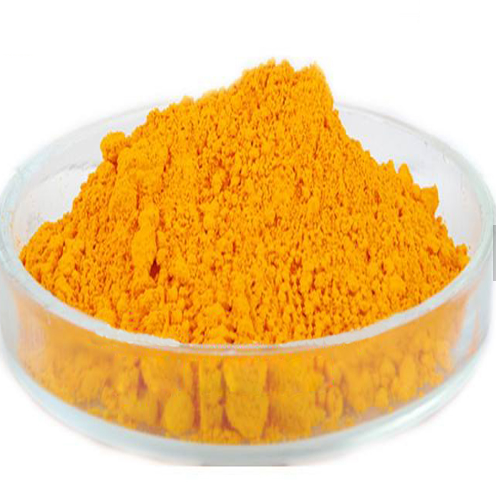
| Product Name: | Riboflavin 5'-Monophosphate Sodium Salt |
| Other Name | riboflavin5'-(dihydrogenphosphate),monosodiumsalt;flavinmononucleotidesodium* electrophoresisreag; riboflavin5-(sodiumhydrogenphosphate); RIBOFLAVIN5-PHOSPHATESODIUMUSChemicalbookP; Riboflavine5'-monophosphateSodiumsalt,PhEur;FLAVINMONONUCLEOTIDESODIUM* ELECTROPHORESISREAGEN; Riboflavin-5'-MonophosphateSodium;VitaminB25'-phosphatemonosodiumsalt |
| CAS NO: | 130-40-5 |
| Molecular formula: | C17H20N4NaO9P |
| Molecular weight: | 478.33 |
Introduction:
Sodium riboflavin phosphate (vitamin B2) is part of the vitamin B group. It is central component of the cofactors FAD and FMN and as such required for a variety of flavoprotein enzyme reactions including activation of other vitamins. It was formerly known as vitamin G.
Function:
1) Riboflavin Sodium Phosphate is an active ingredient for sophisticated cosmetic skin-care products. Riboflavin Sodium Phosphate is a stable vitamin C derivative. Riboflavin Sodium Phosphate protects the skin, promotes its development and improves its appearance.
2) Riboflavin Sodium Phosphate is cleaved enzymatically in the skin to release active vitamin C. Sodium Ascorbyl Phosphate is therefore an effective antioxidant which protects the cells against damage caused by free radicals.
3) Riboflavin Sodium Phosphate counteracts skin aging in promoting collagen formation. Riboflavin Sodium Phosphate also acts on the melanine formation process to prevent hyperpigmentation and senile keratosis. Riboflavin Sodium Phosphate therefore has skin lightening properties.
4) Because of its wide spectrum of action, Riboflavin Sodium Phosphate is suitable for use in a wide range of skin care products. As an effective water soluble anti-oxidant which is stable in cosmetic formulation it is the perfect completion to Vitamin E Acetate, which is the common oil soluble equivalent. The oil soluble Vitamin E Acetate together with the water soluble Sodium Ascorbyl Phosphate are the perfect anti-oxidant system in all skin-care formulations which are used against the daily environmental stress for the skin.
Application
(1)Methylcobalamin is a synthetic (man-made) form of vitamin B12. Naturally occurring vitamin B12 is found in fish, seafood, milk, egg yolk and fermented cheeses.
(2) Methylcobalamin is essential to the development of healthy blood cells, nerve cells, and proteins in the body and for the normal metabolism of fats and carbohydrates in the body. Lack of vitamin B12 can result in anemia, stomach problems,and nerve damage.
(3)Methylcobalamin treats or prevents vitamin B12 deficiency and a resulting type of anemia, called pernicious anemia.
(4)Methylcobalamin is provide for who can't absorb vitamin due to a defect or disease of the stomach or intestines.
COA
TEST ITEM |
|
RESULTS | ||||
Appearance | Orange yellow crystalline hygroscopic powder | Confirmed | ||||
Color and Fluorescence of solution | The solution is pale greenish yellow by transmitted light,and it exhibits an intense yellowish green fluorescence by reflected light under long-wavelength UV light that disappears upon the addition of mineral acids or alkalies. | Confirmed | ||||
Solubility | Soluble in water,very slightly soluble in alcohol,practically insoluble in ether. | Confirmed | ||||
Suitable for | Vegan | Confirmed | ||||
GM Status | GM-free | Confirmed | ||||
Irradiation | Non-irradiated | Confirmed | ||||
Identification | E101 Riboflavin | Confirmed | ||||
Tests the Sodium and Phosphate | Meets the requirements | Meets the requirements | ||||
Free Phosphate | Not more than 1% as PO4 | Less than 1% | ||||
Free Riboflavin | Not more than 6% (dried basis) | 3.7% | ||||
Riboflavin diphosphate | Not more than 6% (dried basis) | 3.85% | ||||
Limit of Lumiflavin | Absorbance:Not more than 0.025 | 0.001 | ||||
Residue on Ignition | Not more than 25% | 23.9% | ||||
Specific Optical Rotation | +37.0°-+42° | +40.05° | ||||
Loss on Drying | Not more than 7.5% | 4.95% | ||||
PH | 5.0-6.5 | 5.9 | ||||
Organic Volatile Impurities | Chloroform | Less than 50 ppm | ||||
1,4-Dioxane | Less than 350 ppm | |||||
Methylene chloride | Less than 600 ppm | |||||
Trichlorooethylene | Less than 85 ppm | |||||
Identification IR | Similar with the Reference Spectrum | Confirmed | ||||
Heavy metals | ≤ 10ppm | Confirmed | ||||
Assay | 73%-79% | 74.40% | ||||
Conclusion | Confirmed with the requirement. | |||||
Tested by | Fangchao Yang | Approved by | Jicheng Niu | |||